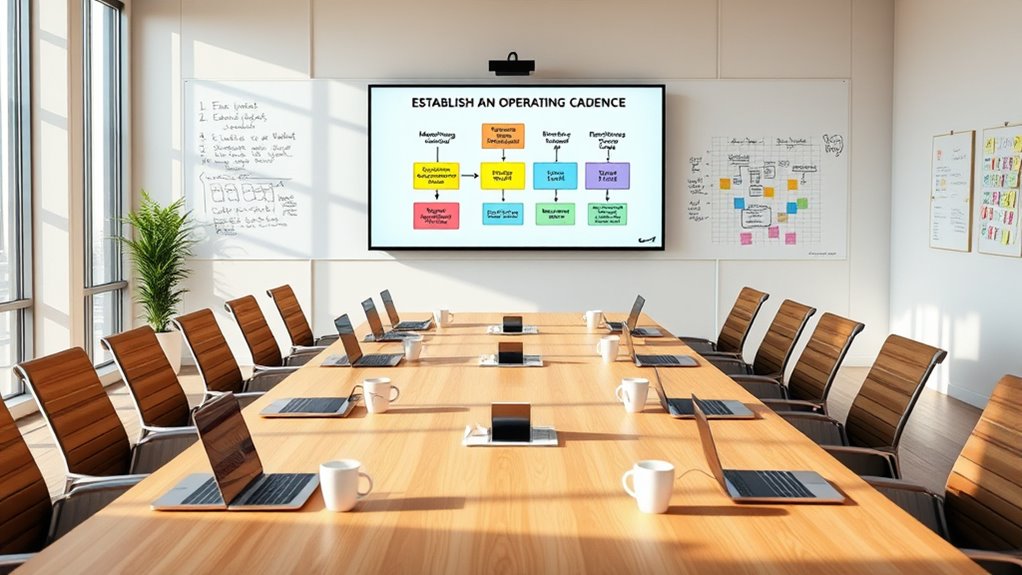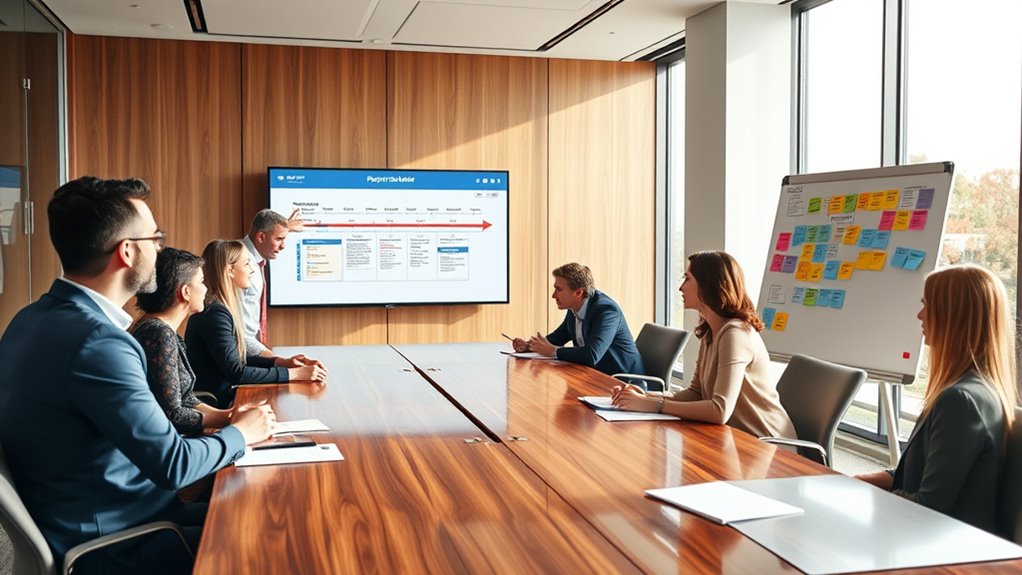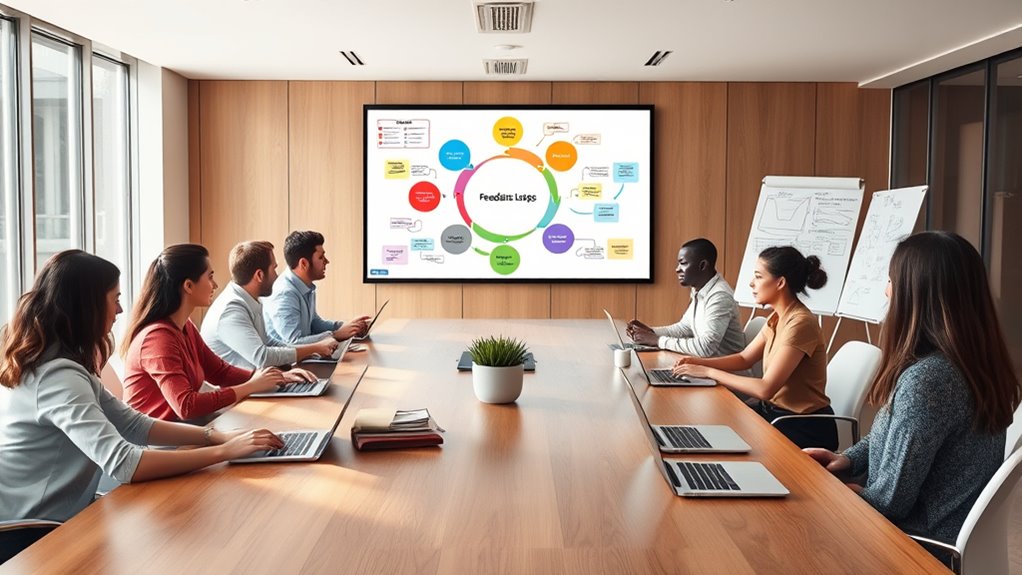To build an effective operating cadence, start by evaluating your organization’s goals and needs. Define core meetings with clear agendas and keep their frequencies consistent to maintain momentum. Assign roles and responsibilities to guarantee accountability, and use tools to monitor progress and action items. Foster open communication and collect feedback to refine your system over time. Incorporate technology for collaboration and discipline, helping you stay agile as you continue implementing proven strategies.
Key Takeaways
- Assess organizational priorities and define clear objectives to tailor the meeting frequency and structure effectively.
- Establish core meeting cadences (weekly, monthly, quarterly) aligned with team and organizational needs.
- Clearly outline roles, responsibilities, and agendas to ensure accountability and focused discussions.
- Integrate performance metrics and feedback mechanisms to monitor progress and facilitate continuous improvement.
- Leverage technology tools for automation, tracking, and transparent communication to support a disciplined operating rhythm.
Assess Your Organizational Needs and Goals

Before establishing an effective operating cadence, you need to clearly understand your organization’s needs and goals. This step is vital for achieving organizational alignment, ensuring everyone works toward common objectives. Start by reviewing your strategic planning documents to identify priorities, long-term visions, and key performance indicators. Determine which processes require regular oversight and where communication gaps might exist. Understanding your organization’s unique context helps you tailor the cadence to support collaboration and accountability. Being aware of internal communication structures and how information flows within your organization can further optimize your operating rhythm. Recognizing the importance of consistent timing in meetings and check-ins ensures that progress is sustained and momentum is maintained. Incorporating effective communication channels can enhance clarity and reduce misunderstandings. Additionally, analyzing your current workflow processes can identify areas where the cadence can improve efficiency. A thorough understanding of organizational culture can help you design an operating rhythm that encourages engagement and participation from team members. By clarifying these needs upfront, you set a solid foundation for designing meetings and check-ins that drive progress and reinforce strategic alignment. This targeted approach ensures your operating rhythm is purposeful, efficient, and aligned with your organization’s overarching goals.
Define Core Meeting Cadences and Frequencies

Establishing the right meeting cadences and frequencies is essential for maintaining momentum and ensuring consistent communication across your organization. You need to tailor your meeting frequency to suit different teams and objectives, enabling smooth operations without causing meeting fatigue. Consider cadence customization to fit each group’s needs: – Weekly check-ins for project teams to address immediate issues – Monthly leadership meetings to review strategic goals – Quarterly all-hands to align the entire organization – As-needed sessions for urgent topics. Balancing these cadences helps keep everyone informed and engaged without overwhelming your team. Regularly review and adjust your meeting frequency to optimize productivity and ensure your operating cadence remains effective. Additionally, implementing meeting frequency practices can enhance team coordination by preventing over-scheduling and ensuring timely updates. Understanding sound healing science and its principles can also support your operational rhythm by promoting a calm and focused work environment, reducing stress and improving overall team well-being. Incorporating well-being tips into your routine can further sustain team resilience and engagement over time.
Establish Clear Agenda and Objectives for Each Meeting

To make your meetings effective, you need to set a clear agenda and define specific objectives beforehand. Start by prioritizing agenda items to ensure the most important topics are addressed first, helping maintain focus and meeting punctuality. A well-structured agenda guides the discussion, prevents tangents, and keeps participants aligned on goals. Clearly stating objectives for each meeting ensures everyone understands what needs to be accomplished, fostering accountability and efficiency. Communicate the agenda in advance so attendees can prepare, reducing delays and interruptions. When agenda prioritization is clear and objectives are specific, meetings stay on track, respect participants’ time, and produce actionable outcomes. Incorporating effective planning techniques can further enhance meeting productivity and ensure strategic alignment. Establishing a consistent meeting rhythm helps reinforce accountability and keeps team members aligned over time. This foundation sets the tone for productive sessions that advance your organizational goals effectively. Additionally, understanding hackathon principles can inspire innovative approaches to internal project collaboration and problem-solving during your meetings. Recognizing the importance of meeting cadence can also help in maintaining ongoing momentum and continuous improvement. Building on this, being aware of emerging roles such as AI Ethicist Jobs can inform how organizations develop frameworks for responsible AI use, which may influence future strategic discussions.
Assign Roles and Responsibilities to Ensure Accountability

Assigning clear roles and responsibilities is essential to guarantee accountability within your meetings. When you define who does what, you ensure responsibility mapping and role clarity, which keeps everyone aligned. To achieve this, consider these steps:
Clear roles and responsibilities ensure accountability and keep your team aligned.
- Clearly outline each team member’s role and expectations
- Assign specific responsibilities for meeting outcomes
- Communicate roles openly to prevent overlaps and gaps
- Regularly review and adjust responsibilities as needed
- Incorporate essential oils for role clarity to create a calming and focused meeting environment.
- Recognize the importance of skilled facilitation to maintain engagement and direction.
- Additionally, establishing transparent communication channels supports ongoing accountability and fosters trust among team members.
- Understanding security roles and responsibilities can further improve team coordination in security-related tasks.
- Promoting mindfulness practices during meetings can enhance focus and reduce misunderstandings.
This approach ensures accountability by making it evident who owns each task. When roles are well-defined, team members understand their contributions, reducing confusion and increasing efficiency. Responsibility mapping helps you track progress and reinforces role clarity, creating a structured environment where accountability thrives. Clear roles lead to more productive meetings and better team performance.
Implement Systems for Tracking Progress and Action Items

How can you guarantee that progress and action items don’t fall through the cracks? Implementing systems for tracking progress is essential. Use tools that monitor performance metrics to measure ongoing results objectively. Set clear deadlines and assign specific owners to each task, ensuring accountability. Incorporate feedback mechanisms to gather insights on what’s working and what’s not, allowing for timely adjustments. Regularly review these systems during your operating cadence meetings, so everyone stays aligned. Automate updates where possible to reduce manual oversight and improve accuracy. By establishing transparent tracking methods, you make progress visible, maintain momentum, and quickly identify issues before they escalate. This structured approach keeps your team focused and ensures that no critical action item gets overlooked. Additionally, leveraging professional hair color brands can help ensure color results remain consistent and vibrant, preventing setbacks related to color fading or uneven application. Incorporating performance metrics derived from industry standards can further refine your tracking system, making it more precise and actionable. Moreover, understanding Louisiana alimony laws can help anticipate legal requirements and timelines associated with support obligations.
Foster Open Communication and Feedback Loops

Fostering open communication and feedback loops is essential for maintaining a healthy and agile team environment. You need to cultivate a feedback culture where everyone feels safe to share ideas and concerns. Encourage open dialogue by actively listening and responding constructively. This creates trust and transparency, empowering team members to contribute meaningfully. To embed this into your operating cadence, consider:
Foster open dialogue and trust to build a transparent, agile, and engaged team environment.
- Regularly soliciting feedback during meetings
- Recognizing contributions openly
- Creating channels for anonymous input
- Promptly acting on feedback received
Adjust and Refine the Operating Cadence Over Time

Once you’ve established open channels for communication and feedback, the next step is to continuously adapt and refine your operating cadence. You need adaptive strategies that allow you to respond to changing circumstances and team needs effectively. Regularly review how well your current schedule supports collaboration and goal achievement. Incorporate feedback from team members and stakeholders to identify areas for improvement. Be willing to experiment with meeting frequencies, formats, and timing, then assess what works best. This ongoing process ensures your cadence remains aligned with your objectives and operational realities. By actively engaging in feedback integration and making data-driven adjustments, you create a flexible, resilient rhythm that enhances productivity and keeps your team focused and engaged over time.
Use Technology to Support Consistency and Collaboration

Using technology effectively can make your operating cadence more consistent and collaborative. By selecting the right tools, automating routine tasks, and tracking engagement metrics, you can keep everyone aligned and productive. These steps help guarantee your team stays on track and continuously improves.
Select Collaborative Tools
How can you guarantee your team stays aligned and productive? Selecting the right collaborative tools is essential. These tools facilitate cross-functional alignment and stakeholder engagement, ensuring everyone stays on the same page. Look for platforms that streamline communication and document sharing, making collaboration seamless. Consider tools that support real-time updates to keep everyone informed and engaged. Prioritize solutions that integrate with your existing systems to minimize disruption. Also, choose options with task management features to track progress clearly. The goal is to foster transparency and accountability across teams. The right technology reduces miscommunication, enhances engagement, and keeps your operating cadence consistent. Ultimately, your tools should empower your team to work efficiently and stay aligned toward shared goals.
Automate Routine Tasks
Automating routine tasks is essential for maintaining a consistent operating cadence and freeing up your team’s time for higher-value work. By leveraging technology for process automation, you improve time management and reduce manual errors. Choose tools that integrate seamlessly with your workflows to streamline repetitive tasks like reporting, reminders, and approvals. Here’s a quick comparison:
| Manual Tasks | Automated Tasks |
|---|---|
| Time-consuming | Faster, more efficient |
| Prone to errors | Accuracy improved |
| Less scalable | Easily scalable |
| Requires oversight | Minimal oversight |
| Demands resources | Saves resources |
Using process automation keeps your team focused on strategic initiatives while establishing reliable routines, ensuring your operating cadence stays consistent and productive.
Track Engagement Metrics
Are you effectively monitoring engagement metrics to make certain your team stays aligned and collaborative? Using technology for engagement analytics helps you track performance benchmarking and identify areas needing improvement. To guarantee consistency, consider these strategies:
- Implement dashboards that provide real-time engagement data
- Use analytics tools to measure participation and responsiveness
- Set clear benchmarks for team performance and monitor progress
- Regularly review metrics to adjust your operating cadence accordingly
These tools enable you to spot trends, foster accountability, and keep communication transparent. By leveraging engagement analytics, you stay proactive in maintaining team cohesion. Consistent tracking helps you make informed decisions, ensuring your operating cadence remains effective and collaborative.
Cultivate a Culture of Discipline and Continuous Improvement

To build a strong operating cadence, you need to establish routine checks that keep everyone accountable and aligned. Encouraging a growth mindset helps your team see challenges as opportunities to improve rather than setbacks. By fostering discipline and continuous learning, you set the foundation for sustained progress and innovation.
Establish Routine Checks
Establishing routine checks is essential for fostering a culture of discipline and continuous improvement. Regular reviews keep your team motivated and ensure everyone stays aligned with goals. These checks create accountability and highlight areas for growth. To make them effective, consider:
- Scheduling consistent team meetings to discuss progress
- Using leadership training to develop managers’ ability to identify issues early
- Encouraging open feedback to promote transparency
- Tracking key performance indicators to measure success
Promote Growth Mindset
Fostering a growth mindset is essential for embedding discipline and continuous improvement into your team’s culture. When you encourage learning agility, team members become more adaptable and open to new challenges. This mindset promotes resilience and a focus on progress, not just outcomes. To cultivate this environment, emphasize effort, learning from mistakes, and curiosity. Here’s a quick guide:
| Action | Example | Benefits |
|---|---|---|
| Encourage experimentation | Try new approaches without fear | Boosts learning agility |
| Recognize effort, not just results | Celebrate persistence | Reinforces a growth mindset |
| Provide ongoing feedback | Regular check-ins | Supports continuous improvement |
| Promote learning opportunities | Training and cross-training | Enhances adaptability |
This approach transforms your team into a dynamic, resilient force ready for growth.
Frequently Asked Questions
How Do I Tailor the Cadence for Different Team Sizes?
You tailor your operating cadence based on team size by adjusting meeting frequency for ideal engagement. For smaller teams, hold more frequent check-ins to foster collaboration, while larger teams benefit from less frequent, more structured meetings to avoid overload. Incorporate team size customization by setting clear agendas and expectations, ensuring everyone stays aligned without unnecessary meetings. Regularly review and tweak the cadence to keep it effective as your team evolves.
What Are Common Pitfalls When Establishing an Operating Rhythm?
You might stumble if you don’t set the right meeting frequency or neglect clear agenda setting. Too many meetings can cause fatigue, while too few hinder communication. Poorly defined agendas lead to off-topic discussions and wasted time. To avoid these pitfalls, customize your rhythm based on team needs, keep agendas focused, and regularly review if your meeting cadence supports your goals. This keeps your operating rhythm effective and engaging.
How Can Remote Teams Effectively Maintain Meeting Consistency?
You might think remote teams struggle with meeting consistency, but with virtual check-ins and asynchronous updates, you can keep everyone aligned. Regularly scheduled virtual check-ins foster accountability, while asynchronous updates allow team members to share progress on their own schedules. By combining these methods, you create a flexible yet disciplined rhythm that maintains communication, guarantees transparency, and keeps your team engaged, no matter where they are located.
What Metrics Best Measure the Success of Our Operating Cadence?
You should focus on performance indicators like meeting attendance, timely agenda completion, and action item follow-through to gauge success. Additionally, measure stakeholder engagement by tracking participation levels, feedback quality, and overall satisfaction. These metrics reveal how well your operating cadence keeps everyone aligned and productive. Regularly reviewing these indicators helps you identify areas for improvement, ensuring your team stays focused, collaborative, and efficient over time.
How Often Should We Revisit and Revise Our Operating Schedule?
You should revisit and revise your operating schedule quarterly or whenever significant changes occur. This guarantees feedback loops remain effective and stakeholder alignment stays strong. Regular reviews help identify bottlenecks, adapt to new priorities, and improve your processes. By maintaining a consistent schedule, you foster continuous improvement, keep everyone aligned, and ensure your operating cadence evolves with your organization’s needs.
Conclusion
By building a deliberate operating cadence, you create a rhythm that naturally aligns your team’s efforts with your goals. When you stay flexible and open to adjustments, you’ll find that progress flows more seamlessly—almost as if timing itself conspires in your favor. Embrace this continuous refinement, and you’ll discover that consistency and communication become your most reliable allies, subtly shaping success in ways you might not initially foresee.









